The Intel SSD 600p (512GB) Review
by Billy Tallis on November 22, 2016 10:30 AM ESTATTO
ATTO's Disk Benchmark is a quick and easy freeware tool to measure drive performance across various transfer sizes.
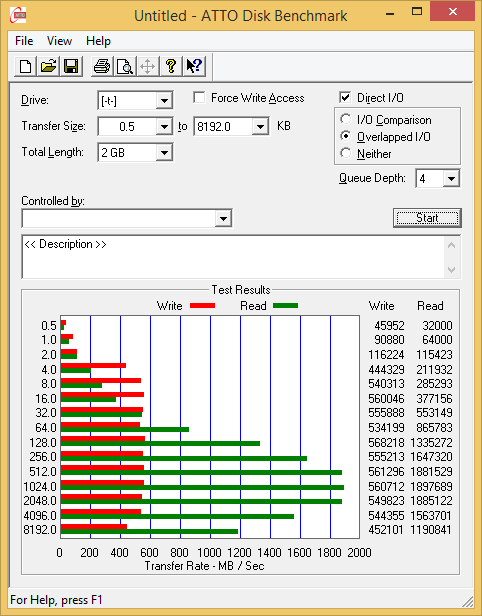 |
|||||||||
Both read and write speeds fall off toward the end of the ATTO test, indicating that thermal throttling is starting to happen. When limited to PCIe 2.0 x2, the performance is somewhat variable and does not show any clear signs of thermal throttling.
AS-SSD
AS-SSD is another quick and free benchmark tool. It uses incompressible data for all of its tests, making it an easy way to keep an eye on which drives are relying on transparent data compression. The short duration of the test makes it a decent indicator of peak drive performance.
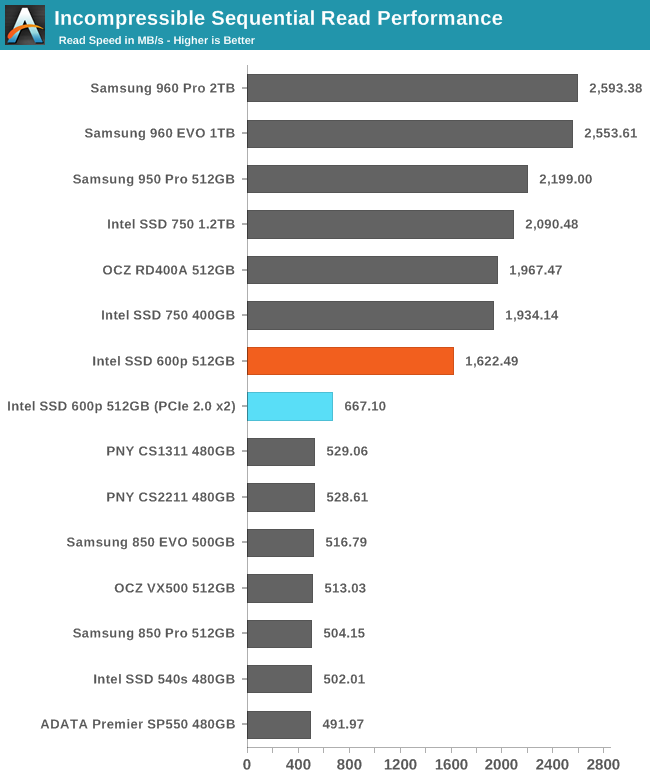
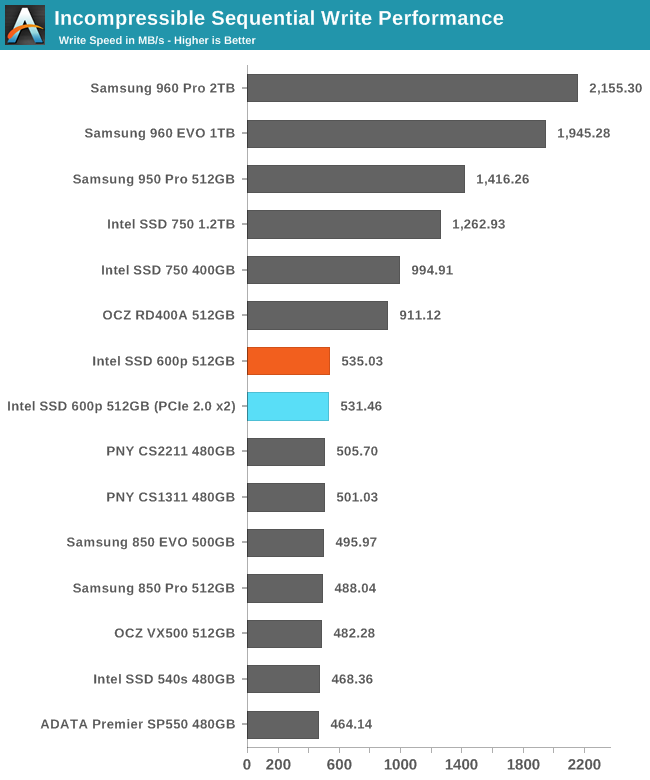
On the short AS-SSD test, the 600p delivers a great sequential read speed that puts it pretty close to high-end NVMe drives. Write speeds are just a hair over what SATA drives can achieve.
Idle Power Consumption
Since the ATSB tests based on real-world usage cut idle times short to 25ms, their power consumption scores paint an inaccurate picture of the relative suitability of drives for mobile use. During real-world client use, a solid state drive will spend far more time idle than actively processing commands.
There are two main ways that a NVMe SSD can save power when idle. The first is through suspending the PCIe link through the Active State Power Management (ASPM) mechanism, analogous to the SATA Link Power Management mechanism. Both define two power saving modes: an intermediate power saving mode with strict wake-up latency requirements (eg. 10µs for SATA "Partial" state) and a deeper state with looser wake-up requirements (eg. 10ms for SATA "Slumber" state). SATA Link Power Management is supported by almost all SSDs and host systems, though it is commonly off by default for desktops. PCIe ASPM support on the other hand is a minefield and it is common to encounter devices that do not implement it or implement it incorrectly. Forcing PCIe ASPM on for a system that defaults to disabling it may lead to the system locking up; this is the case for our current SSD testbed and thus we are unable to measure the effect of PCIe ASPM on SSD idle power.
The NVMe standard also defines a drive power management mechanism that is separate from PCIe link power management. The SSD can define up to 32 different power states and inform the host of the time taken to enter and exit these states. Some of these power states can be operational states where the drive continues to perform I/O with a restricted power budget, while others are non-operational idle states. The host system can either directly set these power states, or it can declare rules for which power states the drive may autonomously transition to after being idle for different lengths of time.
The big caveat to NVMe power management is that while I am able to manually set power states under Linux using low-level tools, I have not yet seen any OS or NVMe driver automatically engage this power saving. Work is underway to add Autonomous Power State Transition (APST) support to the Linux NVMe driver, and it may be possible to configure Windows to use this capability with some SSDs and NVMe drivers. NVMe power management including APST fortunately does not depend on motherboard support the way PCIe ASPM does, so it should eventually reach the same widespread availability that SATA Link Power Management enjoys.
We report two idle power values for each drive: an active idle measurement taken with none of the above power management states engaged, and an idle power measurement with either SATA LPM Slumber state or the lowest-power NVMe non-operational power state, if supported.
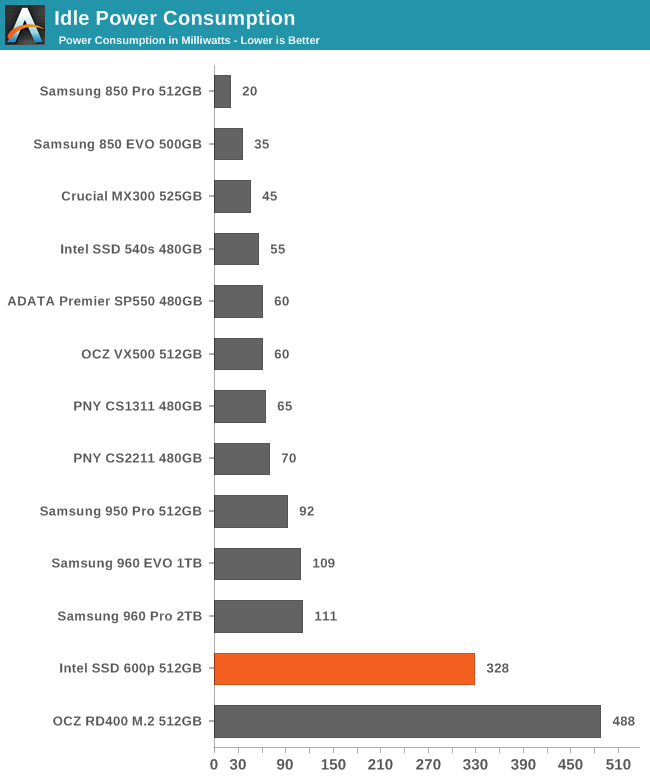
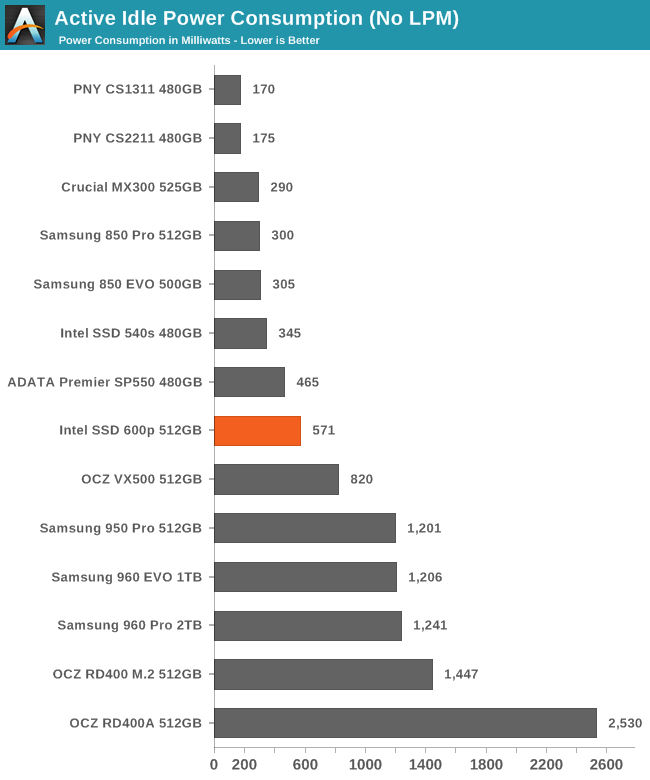
Silicon Motion has made a name for themselves with very low power SSDs. The SM2260 used in the Intel 600p doesn't really keep that tradition alive. It does support NVMe power saving modes, but they don't accomplish much. The active idle power consumption without NVMe power saving modes is much better than the other PCIe SSDs we've tested, but still relatively high by the standards of SATA SSDs.










63 Comments
View All Comments
ddriver - Tuesday, November 22, 2016 - link
A fool can dream James, a fool can dream...He also wants to live in a really big house made of cards and bathe in dry water, so his hair don't get wet :D
Kevin G - Wednesday, November 23, 2016 - link
Conceptually a PCIe bridge/NVMe RAID controller could implement additional PCIe lanes on the drive side for RAID5/6 purposes. For example, 16 lanes to the bridge and six 4 lane slots on the other end. There is still the niche in the server space where reliability is king and having removable and redundant media is important. Granted, this niche is likely served better by U.2 for hot swap bays than M.2 but they'd use the same conceptual bridge/RAID chip proposed here.vFunct - Wednesday, November 23, 2016 - link
> However WHY would you want to do that when you could just go get an Intel P3520 2TB drive or for higher speed a P3700 2TB drive.Those are geared towards database applications (and great for it, as I use them), not media stores.
Media stores are far more cost sensitive.
jjj - Tuesday, November 22, 2016 - link
And this is why SSD makers should be forced to list QD1 perf numbers, it's getting ridiculous.powerarmour - Tuesday, November 22, 2016 - link
I hate TLC.Notmyusualid - Tuesday, November 22, 2016 - link
I'll second that.ddriver - Tuesday, November 22, 2016 - link
Then you will love QLCBrokenCrayons - Wednesday, November 23, 2016 - link
I'm not a huge fan either, but I was also reluctant to buy into MLC over much more durable SLC despite the cost and capacity implications. At this point, I'd like to see some of these newer, much more durable solid state memory technologies that are lurking in labs find their way into the wider world. Until then, TLC is cheap and "good enough" for relatively disposable consumer electronics, though I do keep a backup of my family photos and the books I've written...well, several backups since I'd hate to lose those things.bug77 - Tuesday, November 22, 2016 - link
The only thing that comes to mind is: why, intel, why?milli - Tuesday, November 22, 2016 - link
Did you test the MX300 with the original firmware or the new firmware?